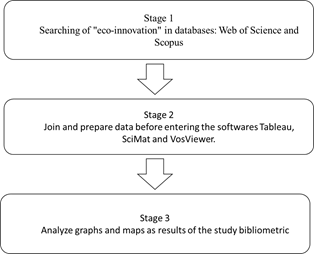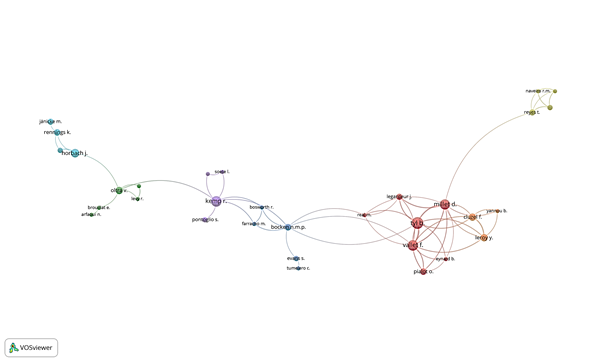1. Introduction
Industrialization has led to the consumption of large amounts of natural resources and, at the same time, a high consumption of energy. Therefore, companies and organizations are interested in eco-innovation since it promotes eco-efficient products, processes, and services for the achievement of sustainable development [34,55]. At the same time, regulations and organizational culture are critical factors for promoting environmental innovation [29,32]. However, the capacities of companies to promote eco-innovation are still limited because the measurement of indicators focused on eco-innovation is required, which allows self-regulation; At the same time, investment in research and development focused on this purpose is necessary [14].
The introduction of eco-innovation must generate positive environmental change by meeting the demand for user-oriented innovation, significantly reducing its environmental impact [31]. In this way, the importance of green products for relevant actors such as politicians, governments and society has grown in recent years [10] to integrate the environmental perspective into their objectives and strategies [33].
However, there are different types of eco-innovation [19] based on their drivers, such as supply and demand, government regulations, control of greenhouse gas emissions, and energy reduction. Eco-innovation emphasizes environmental performance for the efficiency of material resources by reducing waste and energy [21]. Besides, the inclusion of regulations such as ISO 14001 strengthens environmental management systems but does not significantly impact the adoption of eco-innovations; the latter are motivated by cost savings, which drives environmental research and development [13]. On the other hand, implementing new tools and environmental theories implies facing essential barriers such as cultural ones, consumer awareness, and business people's commitment, which depend on the human factor and are more challenging to deal with than technological barriers [26].
In line with the above, technological, social, and institutional changes have to incorporate to establish policies that allow the establishment of eco-innovation [9,44]. On the other hand, the best practices disseminated by the OECD and other European institutions promote green and sustainable growth [11,23].
This document analyzes the evolution of eco-innovation from research from 1996 to 2022 through a bibliometric study [8] to identify the theories put forward. This document presents a general introduction to the concept of eco-innovation followed by section of methodology where describing the bibliometric methodology both for the collection of documents extracted from the Web of Science and Scopus databases, as well as the software used for bibliometric analysis; In the results and discussions section, the trend of the scientific production of eco-innovation, the principal authors and the journal where they have published are analyzed; the leading journals and their classification based on impact factor indicators; the relationship of keywords and their trend in the study period; co-authorship analysis; evolution of the main topics that have interacted with eco-innovation in the study period and identification of possible topics or lines of future research, focused on the social, political and environmental fields.
Finally, in the conclusions section, the research related to the objective of this work is highlighted, which is the visualization of the evolution of eco-innovation in the social, political, and environmental fields, introducing future lines of research. This article provides an overview of the principal authors, keywords, nations, organizations, and journals directly connected to the topic of interest [25,38]; that generates added value for professionals and researchers interested in eco-innovation and its implications in the business, social, political, and environmental fields.
2. Methodology
The literature review is one of the first steps for research, this document provides a priori information on the study of eco-innovation, going through three phases according to Fig. 1: search for information, organization, and information analysis [17].
In the first phase, the search is carried out in the databases with the keyword eco-innovation, compiling the files in *.cvs, *.rif, and *.bib formats from the WoS and Scopus databases, (Table 1). The databases obtained are integrated for analysis in the Tableau, Sci-Mat y VOSviewer software proposed for this study which one. For this reason, it is necessary to integrate all the files into the next phase.
The second phase of organizing the files are integrated into the Tableau software before being used in VOSviewer and Sci-mat, obtaining a single database that rules out repeated work allows the data in joint able to be analyzed in the analyzed software. This software calculates quantitative bibliometric indicators for the processing of scientific production. Bibliometrics is a growing scientific branch [35,55], and bibliometric studies are scientific investigations based on literary history. Based on the bibliometric study, the performance of countries, universities, journals, and authors is analyzed. They are evaluated through bibliometric mapping to visualize trends and structures in scientific information [4,39].
Table 1 Search fields of the concept of eco-innovation.
| Equation of search | Period | Idiom | Type of document | Data base |
|---|---|---|---|---|
| Eco-innovation OR ecoinnovation | All years (1996-2022) | English | Article OR Book OR Book Chapter OR Book Review OR Proceedings Paper | Web of Science and Scopus |
Source: Own elaboration
Finally, in the third stage, the graphs, maps, and tables are obtained, the result of processing the filtered database in the second stage. The application of specialized software in bibliometrics allows us to visualize trends in the main topics of this study related to eco-innovation, such as principal authors, journals, keywords, and institutions.
3. Results and discussion
In the results' analysis phase, graphs and maps were obtained in each software implemented in the study. This section is integrated with subsections according to the software used, starting with Tableau software for data integration and following with Voswiever and SciMat specialized bibliometric software.
3.1. Data processed in Tableau
The data evaluated in Tableau allows us to visualize the total number of documents published in the period 1996-2022 and provides us with the total number of citations obtained annually. We can see in Fig. 2 that the first eco-innovation document was published in 1996; it was in the year 2000 when the citations of five published documents emerged, and as of this year, the trend has been incremental.
The year 2014 had the highest number of citations, 12,297 with 171 published documents. The year 2021 has registered the highest number of published documents and, the forecast for the next five years is incremental. On the other hand, the forecast for the number of citations is seasonal for the next few years.
Based on the data processed in Tableau, Fig. 3 shows the top ten authors by number of citations. Among these, we can find [3], with 1293 citations with the article "A Literature and Practice Review to Develop Sustainable Business Model Archetypes", published in the journal Building and Environment, with a Q1 quartile. In second place, we find [48-50], with three publications accumulating 1,168 citations in the journals Journal of Cleaner Production, Energy Policy, Environmental Innovation and, Societal Transitions; the third place is for [44], with the publication "Redefining innovation - Research on eco-innovation and the contribution of ecological economics" with 1,129 citations.
Fig. 4 show the leading 25 journals are identified based on the number of publications and citations. The Journal of Cleaner Production is the most significant source of eco-innovation documents, with 514 publications that gathered 30,476 citations in the study period 1996-2022, followed by the journal Sustainability with 3,762 citations and 271 papers. The journals that precede the main one show contrast in the number of articles and citations; that is, the number of documents is less, but the number of sources is higher; the journal Ecological Economics has a more significant number of citations (8,125 with 48 documents), while Energy Policy has the same number of documents (48), but with a lower number of citations (3,788). On the other hand, the journal Business Strategy and The Environment has 5,181 citations and 156 papers. Therefore, its color in the graph is darker. The remaining light blue illuminated magazines have between 4 and 51 publications.

Source: Own elaboration, data processed in Tableau, 2022.
Figure 2 Documents and cites of 1996-2022.
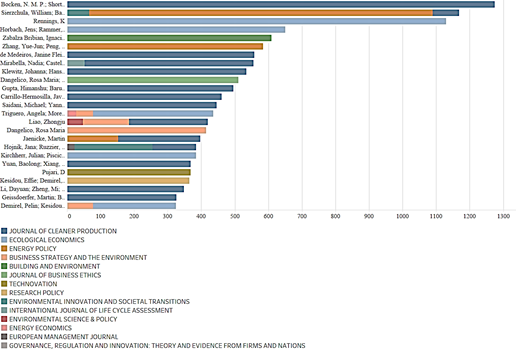
Source: Own elaboration, data processed in Tableau, 2022.
Figure 3 Documents and cites of 1996-2022, processed in Tableau.

Source: Own elaboration, data processed in Tableau, 2022.
Figure 4 Leading journals according to publications and cities.
Table 2 lists the top 10 based on the number of citations and documents, their classification according to the quartile according to the impact factor in which they are located, and their SJR quality indicator. All the listed journals are highly impacted since they are located in quartile 1, highlighting the Journal of Cleaner Production with an SJR indicator of 1.92, although the Research Policy journal has a higher SJR index of 3.53, which surpasses the others listed. This table highlights that the journals that have published papers related to eco-innovation have had high impact.
Table 2 Top 10 of the leading journals.
| Source Title | Times Cited | Documents | Quartil | SJR |
|---|---|---|---|---|
| Journal of Cleaner Production | 30,476 | 514 | Q1 | 1.92 |
| Ecological Economics | 8,125 | 48 | Q1 | 1.78 |
| Sustainability | 3,762 | 271 | Q2 | 0.66 |
| Business Strategy and the Environment | 5,181 | 156 | Q3 | 2.24 |
| Energy Policy | 3,788 | 48 | Q4 | 2.13 |
| Technological Forecasting and Social Change | 2,505 | 74 | Q5 | 2.34 |
| Research Policy | 3,027 | 36 | Q6 | 3.53 |
| Science of the Total Environment | 1,236 | 19 | Q7 | 1.81 |
| Journal of Environmental Management | 1,399 | 43 | Q8 | 1.48 |
| Environmental Innovation and Societal Transition | 1,050 | 21 | Q9 | 2.57 |
Source: Own elaboration
Based on the exposed graphs, the main contributions to our topic of interest are presented below, based on the top authors and magazines. The studies developed involve the study of eco-innovations, eco-efficiency, and good practices in the corporate social field, which implies the introduction of eco-innovation in the administration of businesses aimed at corporate social responsibility. and a redirection to industrial sustainability. The eco-innovation within processes contributes to company performance from an integrating approach [19], which involves suppliers as a fundamental part of environmental management [18].
Along the same lines, eco-innovation is focused on sustainable business models (SBM) to obtain a competitive advantage [3]. On the other hand, eco-innovations capacity must be considered in its design, which is vital to create business opportunities while contributing to a sustainable society [6]. In the social and business field, the authors highlight that environmental awareness has come to influence positively to provide alternatives that mitigate the environmental impact in sustainable business models [16], considering critical factors such as market knowledge, understanding laws and regulations, collaboration and learning, and investments in research and development [12].
3.2. Bibliometric analysis
In this section, analyze the interactions between the authors and the keywords with VOSviewer, which builds network maps that help visually identify clusters of authors, countries, keywords, and organizations [53]. Fig. 5 includes the keywords of all the documents analyzed, in which the words with a minimum occurrence of five per keyword, identifying eight clusters with different colors. The central yellow cluster integrates the word eco-innovation, distinguished with more significant occurrence by the volume of its circle, followed by the keyword sustainable development. In this same cluster, we find keywords with a lower relationship. The keyword innovation heads the blue cluster, and sustainability in the same cluster, followed by innovation. It is worth mentioning that the strength relation is the distance of lines between the circles and the clusters; therefore, these first two are closely related. On the other hand, the purple cluster, led by environmental impact, is linked to all the clusters, although its distance indicates a weak relationship.
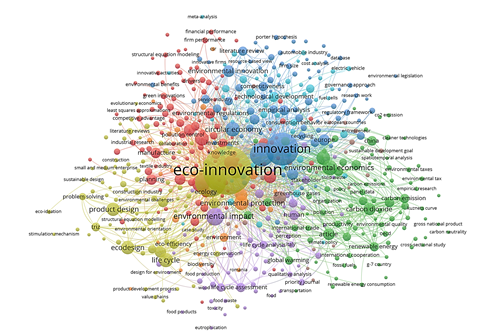
Source: Own elaboration, database processed in VOSviewer
Figure 5 Map of keywords, according to data of WoS and Scopus.

Source: Own elaboration, database processed in VOSviewer.
Figure 6 Map of keywords, according to data of WoS and Scopus.
On the other hand, the keyword map for its development over the years, Fig. 6, show the keywords that stand out for their density and that are related to eco-innovation but that preceded it during the years 2014 and 2016 were eco-design, life cycle, and development product. Subsequently, the most significant development of the eco-innovation keyword was between 2016 and 2018, sharing the same cluster of the period with sustainability, environmental impact, climate change, and ecology among the most prominent. Towards 2020, the topics under development and with little research are carbon emissions, economic development, and environmental tax.
The following co-authorship map, Fig. 7, integrates five clusters that include the authors with a minimum of three documents. We observe that the clusters are linked distantly; there is no common union between them; however, identifying the authors' participation in different sets in parallel is evident. The red cluster is led by [52], and this cluster is joined by the yellow, orange, and blue groups. The authors who stand out from these are the following [7,45], due to the density of their circle; in the blue cluster, the author stands out [3], and this cluster is connecting to the purple collection, where the author stands out [24]. The authors with the highest density in the following green and light blue sets are [20, 40]. It is worth mentioning that the authors have different publications, which are concentrated in Table 3, identifying their main contributions to the subject of study.
The keywords with the highest density related to eco-innovation are in the environmental field, such as environmental impact, ecology, sustainability, environmental economics and circular economy; Those related to the social, business and political aspects, such as human, collaboration, regulations, sustainable development goal, small and medium-sized enterprise, economic growth, economic development, among others, still find a relationship on the periphery of the map, which indicates that their relationship is not so close.
The density of keywords implies their development in the literature related to eco-innovation. However, the relationship of the identified clusters suggests the interrelation of various factors for the execution of a systematic eco-innovation that contributes to environmental improvements [22]: On the other hand, the environmental policy is a factual statement for companies or organizations to follow environmental regulations, assuming social responsibility [29].
4. SciMAT analysis
Sci-Mat is a recent open-source software for bibliometric analysis that allows the mapping of different types of files downloaded from different data sources, making use of different algorithms to generate bibliometric networks. Likewise, it offers significant advantages compared to other bibliometric analysis tools, such as identifying duplicate elements, writing errors, data contraction, and the processing link. On the other hand, it allows a longitudinal analysis with bibliometric measures selected in guided steps [8].
One of the main features of SciMAT is that it facilitates the compilation of different types of files aggregated into the same study. The first step for our analysis was to divide the total number of documents into three periods based on the year of publication: 1996-2006, 2007-2016, and 2017-2022. The result of data processing allows the construction of bibliometric maps, which show the relationships between the study topics and their evolution over time. Fig. 8 illustrates the cross-sectional analysis of the eco-innovation theme through the defined periods. The magnitude of the circle for each one of the topics represents the number of publications in the corresponding period. On the other hand, the lines that join the themes between periods represent their relationship. That is, the continuous lines represent a thematic link between the themes, and the dotted lines represent keyword sharing. Finally, the thickness of the dotted or continuous lines indicates the inclusion index [46].
In this transversal map, Fig. 8, we observe how the topic of ECO-INNOVATION transcends the three periods. From the first to the second period, it is related in a secondary way to SUSTAINABLE DEVELOPMENT, and INNOVATION; On the other hand, it is directly related to ENVIRONMENTAL IMPACT, since eco-innovation is a tool to reduce environmental impact. In the transition from the second to the third period, different concepts directly related to the central theme of eco-innovation; the most relevant ones identified by the thickness of the lines these are ENVIRONMENTAL-ECONOMICS, ENVIRONMENTAL IMPACT, ENVIRONMENTAL MANAGEMENT, ENERGY EFFICIENCY, LIFE CYCLE and INVESTMENTS. The topics that are shared but not found with the main ones are CARBON EMISSION, HUMAN, ENVIRONMENTAL-PROTECTION, INNOVATION, SUSTAINABLE-DEVELOPMENT, and CIRCULAR ECONOMY.
divided into four quadrants divided by two axes with the horizontal axis indicates the centrality of the themes located on the map, and the vertical axis indicates the density of their development. Based on the above, we can interpret and classify the themes located on the map [8,38].
In the first quadrant, located on the upper right side, there are specialized topics with high centrality and density; in the second upper left quadrant, the motor themes are considered motors with few external connections, which is why they are in internal development; the third quadrant, located in the lower left part, includes basic themes with low density and centrality but which are considered potential for development with the central theme; Finally, the fourth lower right quadrant identifies emerging themes for the central theme at the same time that they are considered transversal.
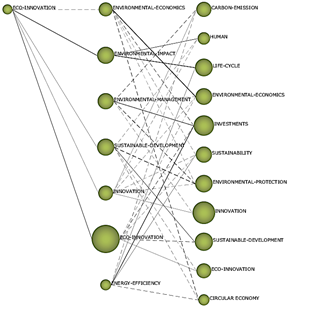
Source: Own elaboration, database processed in SciMAT.
Figure 8 Transversal map of Eco-innovation according to data from WoS.
The following maps show maps developed in Sci-Mat
It is worth mentioning that the density distinguishes the strength of the internal links related to the keywords of the subject under study, that is, their level of development. On the other hand, centrality is related to external interactions with other topics or networks, identifying its integral development in the field of research.
In the first period of our study, only the central theme was identified as a motor theme located in the third quadrant. In this period, this is in development, but with considerable centrality and density as an emerging theme. It is worth mentioning that, like the first map illustrated in Fig. 9, the theme of eco-innovation during this period was new and without related themes.
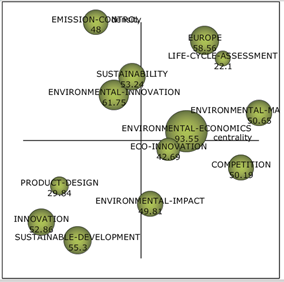
Source: Own elaboration, database processed in SciMAT.
Figure 10 Map for the first period 2007-2016.
In the second period, 2007-2016, different themes are identified in the four quadrants; see Fig. 10. Specialized topics include EMISSION-CONTROL, SUSTAINABILITY, and ENVIRONMENTAL-INNOVATION, with greater centrality and density. In the third quadrant, the motor themes are LIFE-CYCLE-ASSESSMENT, ENVIRONMENTAL MANAGEMENT and ENVIRONMENTAL-ECONOMICS; These topics are in development but has been some research carried out in this period that allows them to be identified as necessary depending on their density and centrality.
In the third period, see Fig. 11, the specialized topic is ENVIRONMENTAL MANAGEMENT, located in the fourth quadrant with a high density and centrality; it is worth mentioning that these two characteristics vary within the same quadrants. At the same time, the second quadrant includes other issues such as ENERGY-UTILIZATION, REGULATORY -FRAMEWORK, WASTE MANAGEMENT, LIFE CYCLE, TAXES, SMALL AND MEDIUM-SIZE-ENTREPRESI and HUMAN. In this cycle, the involvement of different actors and fields of application that identify issues required for the development of eco-innovation is evident. ENVIRONMENTAL PROTECTION and ENVIRONMENTAL TECHNOLOGY "are topics in the emerging quadrant, close to motor topics. On the other hand, CIRCULAR ECONOMIC, COMMERCE, SUSTAINABLE DEVELOPMENT, SUSTAINABILITY, INNOVATION, and ECO-INNOVATION remained basic themes.
The eco-innovation cluster map, Fig. 12, shows the relationship of the main issues that are related, and the weight of their interaction is identified by the thickness of the line that unites them, being ECO-DESIGN, PRODUCT-DESING, PRODUCT-DEVELOPMENT, and ENVIRONMENTAL IMPACT. Likewise, the volume of the sphere of each one of these themes indicates the development of this theme in the literature analyzed in this study.
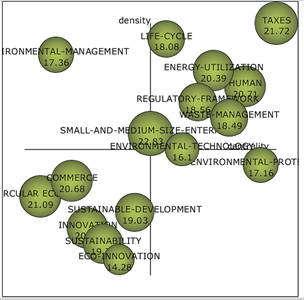
Source: Own elaboration, database processed in SciMAT.
Figure 11 Map for the first period 2017-2022.
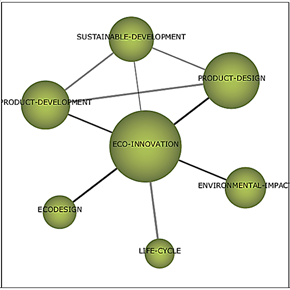
Source: Own elaboration, database processed in SciMAT.
Figure 12 Map of keywords of cluster eco-innovation.
The maps developed in SciMAT allow visualizing the subject of interest longitudinally by periods of time and identifying the works in the literature that include eco-innovation in the design and development of new products in the development of sustainability and in favor of ecology [1,5,15,41,43,54].
5. Conclusions
To conclude, eco-innovation is relatively new in its implementation; His foray into literature began in 1996 and has been growing as a developing topic. In 2000, there were five documents, which reached 2,485, and by 2014, with 171 documents, 12,297 citations were obtained, even though this result was not confirmed. An average increase of 67 documents in scientific production is forecast. On the other hand, the author with the highest number of citations is [2,3], followed by [49] and [44]. Likewise, the journal that ranks first in eco-innovation publications is the Journal of Cleaner Production, with 30,476 citations and 514 documents, during our study period. It is worth mentioning that the top 10 journals: Journal of Cleaner Production, Ecological Economics, Sustainability, Business Strategy and the Environment, Energy Policy, Technological Forecasting and Social Change, Research Policy, Science of the Total Environment, Journal of Environmental Management, and Environmental Innovation and Societal Transitions, are Q1, which qualifies them with high-quality standards in scientific production.
The main author by the number of citations is [2], whose publication “The eco-innovation interface for eco-innovative small and medium-sized enterprises” in the Journal of Cleaner Production is Q1, like a high-impact magazine. Followed by [48-50], with three publications accumulating 1,168 citations in the Journal of Cleaner Production, Energy Policy and Environmental Innovation and Societal Transitions; and third place goes to [44]. His publications highlight the importance of eco-innovation as a tool that promotes corporate social responsibility, which must be integrated into the business sustainability agenda; At the same time, they question how to integrate eco-innovation to obtain results focused on competitive advantage for the entities that adopt it. Along the same lines, they highlight the importance of policies that regulate eco-innovations.
On the other hand, the bibliometric software allows clear visualization of the behavior of the keywords related to eco-innovation through the maps; On the one hand, VOSviewer highlights the density of the development of the concept of eco-innovation in general, while SciMAT divides the information to analyze it by periods, recording a longitudinal analysis. Both agree that the subject of interest has had a more significant research period, which is intermediate to the general period of the present study. In the VOSviewer maps, the innovation and environmental impact keywords with the highest density and proximity to the eco-innovation keyword; on the other hand, sustainability and environmental impact stand out in the keyword map by periods; this last keyword continues in the transition of the years. Sustainability is a keyword directly related to eco-innovation in favor of reducing environmental impact; this has generated debates on the design of eco-innovations in the political, social, business, and environmental fields, these influencing the planning of products, processes, and organizational structures [14,23,27,28,47].
The concept of eco-innovation has been connected with other research topics, as observed in the maps created with the SciMAT software, highlighting that these do not remain immobile and are investigated with greater or lesser importance within the literature. In the periods divided for the study with this last software, 1996-2006, 2007-2016, and 2017-2022, it is possible to follow the evolution of eco-innovation in the social, political, business, and environmental fields and the relationship between them. In the first period, the concept of eco-innovation remained isolated; in the second-period topics such as life cycle assessment, sustainability, environmental impact, competition, product design, environmental economics, environmental innovation and sustainable development quickly emerged; in the third-period environmental management, life cycle, energy utilization, taxes, human, regulatory framework, waste management, small and medium Enterprise, environmental technology, environmental protect, commerce, sustainable development, innovation and sustainability.
In turn, the study allows visualizing on the cross-sectional map how the eco-innovation keyword has been linked to others throughout the study period, including energy efficiency, environmental management, environmental impact, environmental investments, and the life cycle. The authors emphasize responsible production to guarantee resources for the following generations, reducing energy consumption, and studying the impact of the products consumed through the life cycle study [11,36,42,48,56].
This study of the state of the art in the business, social, political, and environmental spheres fulfilled the objective of giving a panoramic view of eco-innovation evolution, visualizing the trends throughout the period studied. Based on this bibliometric study, concluding that the term eco-innovation is complex as it impacts different areas of companies and organizations committed to the environment. Eco-innovation is a tool ambitiously for restructuring a system that allows the control of environmental impact while achieving business objectives such as being competitive under the guidelines of policies and regulations. This study provides an overview of the evolution of eco-innovation from 1996 to 2022; however, it does not delve into issues related to eco-innovation, so it extends to future research to inquire about specific lines of eco-innovation presented in this work.














